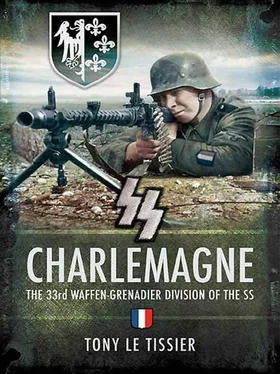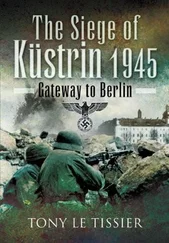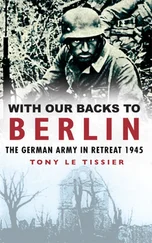The Charlemagne sent two batches of candidates to the officer-cadet school at Neweklau. Some thirty potential officers, mainly LVF, went from Saalesch, while others went direct from their officers’ prisoner-of-war camp. The course lasted three terms, and concentrated on the training of leaders and directing small units on exercise as Panzergrenadiers , using captured Russian T-34 tanks to work with. It also focused on the training of platoon and even company commanders and dealing with tactical problems.
Then in December 1944, a group mainly consisting of former Miliciens plus some former LVF that had already attended the first part of the course either at Deba or at Greifenberg attended just the second part of the Neweklau course. Several old firebrands from the LVF like Walter, Vincenot and Bellanger joined this course voluntarily, not wanting to go back to basic training after two or three years combat experience in Russia. Several of these individuals were to lead companies in Pomerania.
Selected candidates then took an examination at the end of six months. Elimination of unsuitable candidates took place particularly during the second term, and the 200 that had started in December were reduced to 50 by the end of March. ‘Returns to unit’ took place every fortnight, those concerned retaining their ranks and even being eligible for promotion to higher noncommissioned rank.
Conditions at the school were tough, to say the least. Few armies would have subjected their officer-cadets to such rough conditions. There was no heating in the abandoned Czech village, so one was entitled to flap one’s arms once every half hour to warm up. For lack of hot water, the cadets shaved themselves with their morning coffee. They were always hungry, and in order to study at night in their rooms, they had to fashion candles out of boot polish.
Vigour, authority and responsibility were the order of the day. The instructors repeated: ‘You can leave when you want; the door is open. We are not holding back anybody!’ And it was true. ‘We always had the choice,’ wrote one of the candidates, ‘but they were even more demanding once we had decided to continue.’
The candidates were woken up for exercises up to four times a night, and weapon handling took place in temperatures of -15 and -20 °C. But in this selection of an elite, the instructors never had to resort to bullying. Having made an assessment of the fighting on all the fronts, they said: ‘Now it is clear that the war is technically lost, but we continue to be confident. Those who want to go can leave!’
The course finished at the end of March 1945. Some twenty to thirty Frenchmen were classified for promotion to second-lieutenant, but continued to wear the rank badges of officer-cadets, presumably remaining under probation. However, they were unable to rejoin the Division immediately and were first distributed among various units of the Regiment remaining behind, bringing them fresh blood. For three weeks their task was to bolster up the spirits of the young grenadiers demoralised by the fighting in Pomerania. They succeeded marvellously and without them the fighting in Berlin, where many of them were later to fall, would not have been possible.
The school was finally disbanded on 9 April and, apart from a small number sent to the depot at Wildflecken, the students returned to the units in Mecklenburg, where they arrived on 14th.
Meanwhile, those detailed for the specialist tasks within the division were dispersed to courses run at Josefstadt for gunners, Lissa for infantry gunners, Brunschau for engineers, Janowitz-Beneschau for anti-tank and self-propelled gun crews, Sterzing (Viptino) for signallers, Göttingen for mounted troops, Stettin for medical-aid men, Berlin for vehicle mechanics, Oranienburg for interpreters and Breslau for clerks. The last course at Breslau for company-quartermaster-sergeants was unfortunate, as the city was cut off by the Soviets while they were still undergoing their training and they were obliged to take part in the defence.
The Brigade’s only fully trained unit was the flak battery, which had been transferred intact from the SS-French Storm Brigade and was sent off on 3 January 1945 to deploy in defence of the little town of Fulda, a frequent target for Anglo-American air raids. This unit of about 150 men had been designated the Storm Brigade’s Flak Battery and was placed under the command of Captain Maudhuit, a veteran of the First World War, at Neweklau in Czechoslovakia. It contained several other former French Army officers in the current rank of sergeant-major, including Croisille, Crespin, Roy, the Count Foulques de Larentie and the Marquis de Tolosan, a former air attaché in Brussels.
Fayard, an officer-cadet fresh from the Bad Tölz SS School, was then attached to Captain Maudhuit and took over the training. Then Maudhuit was transferred and Sergeant-Major Guignot, a former captain in the Foreign Legion, took over the battery.
However, there were no proper facilities at Neweklau for training the battery, so on 25 April 1944, the unit entrained for Munich, where it was accommodated in the ultra-modern barracks of the SS-Das Reich Panzer Division. Three days later it received its official title as the SS-Französische Flak-Batterie , the only French unit to bear the title of SS, as opposed to Waffen .
Paradoxically, the 3rd Company that provided the Flak nucleus was a kind of disciplinary unit containing the hotheads whose behaviour while on leave in France had led to complaints to the German Military Administration.
At Munich it conducted its training alongside German troops, while the three platoon commanders, Fayard, who was to replace Guignot in the August, Ouvre and Mary attended a platoon commanders’ course elsewhere. The battery also took an active and successful part in the defence of the city and their own barracks against the Anglo-American bombers.
After three month’s training, on 28 July, the battery was issued with new uniforms and entrained for Bruss in the Danzig Corridor, where it was issued with its complete establishment of nine 37mm guns, arms, ammunition and vehicles. It then moved to Saalesch, and Officer-Cadet Fayard, soon to be promoted to second-lieutenant, took over the battery, which began training up to 10 hours a day.
Then, on 31 October, the battery entrained for Wildflecken Camp to join the Charlemagne Brigade. Some two months later, on 3 January 1945, being considered the only unit of the Brigade fit for combat, the Flak Battery was detached in defence of the little town of Fulda, a frequent target of Anglo-American air raids.
With the Greifenberg Depot under the command of Swiss SS-Major Hersche coming under threat from the Russian advance, it was obliged to move to Wildflecken. The Depot units consisted of the 1st Training Company under SS-Second-Lieutenant Schüler, the Depot Company under SS-Lieutenant Allgeier and the Recruit Company under Lieutenant Crespin. Having dispensed with about 250 undesirable or dubious characters, the Depot now amounted to about 400 men.
According to one of the instructors, the value of those elements trained at Greinfenberg was very mediocre. They were good at drill, but were not much use on the ground, not knowing how to conceal themselves or to spread out, and they also lacked firing training.
On 23 January 1945, all these depot elements were formed into a field replacement battalion under Captain Michel Bisiau, which eventually arrived to reinforce the Division at Körlin on 3 March. The final establishment of the Charlemagne Division was as follows:
SS-Grenadier Regiment 57 of two battalions (continuing the SS connection)
SS-Grenadier Regiment 58 of two battalions (continuing the LVF connection)
Читать дальше












